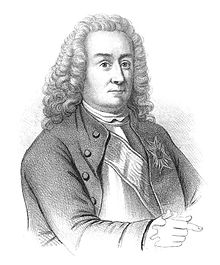Rutger Fuchs
Rutger Freiherr Fuchs (born April 12, 1682 in Malmö ; † April 10, 1753 in Stockholm ) was a Swedish major general , knight of the Seraphine Order , commander of the Order of the Swords and governor .
Life
He was the son of Lieutenant Colonel Christian Fuchs. He came to Sweden in 1648 and became a commandant in Malmö . The mother was Susanna Eleonora Lejonsten.
Rutger Fuchs began his military career in 1699, became a captain in 1704, and served in the Swedish Baltic provinces in Finland until 1707 and then in Sweden . Fuchs became a major in the Dalregiment in 1710 and rose to lieutenant colonel there in 1712. In the same year he followed Magnus Stenbock to Germany . In the battle of Gadebusch he commanded the entire Dal regiment. In this battle he was so badly wounded that he was forced to walk on crutches for a year . In 1716 he took part in the campaign of Charles XII. against Norway. In the same year he was knighted and promoted to colonel , first in the Dal Regiment and then in the Södermans Regiment . He also took part in the second campaign against Norway in 1718. After his homecoming he achieved the greatest feat of his military career. With his regiment , which consisted of 700 to 800 soldiers, he went to battle at Södra Stäket on August 13, 1719 . A Russian overwhelming force trying to take Stockholm was repulsed by the Swedish defenders. This happened in the context of the Russian devastation in Sweden in the years 1719 to 1721. For this achievement Fuchs was appointed baron and promoted to major general.
In the next few years, Fuchs devoted himself entirely to political work. In doing so, he followed the ideas of Arvid Horn . The bellicose mood that developed in the 1730s also influenced the old warrior. At the Swedish Reichstag from 1738 to 1739, Fuchs joined the “Hütepartei” ( Swedish Hattpartiet ). There he worked on a defense plan that empowered the government, under certain circumstances, to declare war on Russia. In 1739 Rutger Fuchs was appointed governor of Stockholm, also under pressure from the estates. It did not take long for Fuchs to part ways with the Hats Party, and as early as 1740 he was very resolute in opposition to war policy. During the following election campaign he appeared in the Mössorna party as a leading and highly respected member.
Rutger Fuchs was married three times, but the marriages remained childless. He died in Stockholm in 1753 and was buried in the Riddarholmskyrkan .
In his memory, several streets in the Stockholm area were named after him, for example Rutger Fuchsgatan in Södermalm and Rutger Fuchsvägen in Saltsjöbaden .
literature
- Carl Snoilsky: Rutger Fuchs . In: Minnesteckningar och andra uppsatser . Hugo Gebers Förlag, Stockholm 1904, pp. 59–128.
- L. Stavenow: Fuchs, Rutger . In: Theodor Westrin (Ed.): Nordisk familjebok konversationslexikon och realencyklopedi . 2nd Edition. tape 9 : Fruktodling – Gossensass . Nordisk familjeboks förlag, Stockholm 1908, Sp. 76-77 (Swedish, runeberg.org ).
Individual evidence
- ↑ a b Rutger Fuchs . In: Theodor Westrin (Ed.): Nordisk familjebok konversationslexikon och realencyklopedi . 2nd Edition. tape 9 : Fruktodling – Gossensass . Nordisk familjeboks förlag, Stockholm 1908, Sp. 76 (Swedish, runeberg.org ).
- ↑ a b c d e Snoilsky, Rutger Fuchs. Retrieved July 24, 2013 (Swedish).
- ↑ a b c d Information about Rutger Fuchs. In: Tripod.com. Retrieved July 24, 2013 (Swedish).
| personal data | |
|---|---|
| SURNAME | Fuchs, Rutger |
| ALTERNATIVE NAMES | Fuchs, Rutger Freiherr |
| BRIEF DESCRIPTION | Swedish Baron, Major General, Knight of the Seraphine Order, Commander of the Order of the Sword and Supreme Governor in Stockholm |
| DATE OF BIRTH | April 12, 1682 |
| PLACE OF BIRTH | Malmo |
| DATE OF DEATH | April 10, 1753 |
| Place of death | Stockholm |
